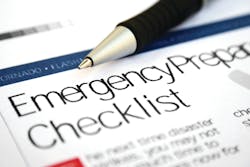The healthcare industry is no stranger to the growing security risks that exist in the world today. High-profile incidents such as the December, 2013 Renown Regional Medical Center shooting in Reno, NV, are a constant reminder that hospitals are facing increased threats. Exposure to such threats—coupled with compliance and budgetary restraints—will put significant pressure on the healthcare security industry in 2014. On top of being the front line in protecting the lives of patients and employees, security will also affect many other facets of healthcare organizations, such as business continuity, human resources and finance. This article will briefly explore how industry trends, new legislation and emerging technologies are shaping healthcare security in 2014.
Industry trends
Affordable Care Act: With the recent implementation of the Affordable Care Act (ACA), there is a pervasive feeling of uncertainty regarding the short term effects on the industry. Hospitals will guard their budgets cautiously, and security—traditionally viewed as a cost center—will feel the pinch. Security directors will be expected to do more with less and will be required to present business cases, citing in-depth, needs-based analysis to obtain funding. Certain hospitals might even see personnel reductions, which will further strain their security departments and lead to guard outsourcing.
Tighter budgets have long been an anticipated side effect of the ACA. The industry as a whole has been used to dealing with decreased funding since the 2008 recession. According to Ray Osborne, CHPA, director of security services at UC San Diego Medical Center, “As with most industries over the past several years, the sluggish economy created budgetary shortfalls in overall healthcare security. While our industry has adapted well to these existing fiscal challenges, the [ACA] is expected to impact healthcare security even further.”
Experts expect a rise in patient volume as more people seek treatment once they become insured. There is potential for health systems to become overwhelmed as a result of the overstretched staff, reduced supplies and increased costs. Hospitals might have to review their visitor management and access control systems, as well as update their training and policies to compensate for the increase of patients and longer wait times.
“In order to be more adequately prepared, healthcare security leaders have challenged themselves with identifying and preparing more efficient ways to accomplish our goals should significant changes occur, all while not compromising the integrity of our programs,” said Osborne.
Security professionals might also be brought into projects not traditionally under their realm. A provision of the ACA states that insurance reimbursements are tied, in part, to a hospital’s patient satisfaction data. Communications and life safety technologies are vital to improving a patient’s overall experience. Technologies such as nurse call systems and real-time patient locating will be in the spotlight. Furthermore, life safety systems will need to be integrated into the overall hospital system. Other departments will lean on the security department to help them implement changes and improve their patient satisfaction data.
Active Shooter: On top of budgetary and regulation issues, healthcare security professionals contend with the day-to-day threats that face their facilities, with a major concern continuing to be an active shooter scenario. According to research by Brad Heath and Meghan Hoyer of USA Today, mass shootings occur once every two weeks in the U.S. While the chances are slim, it is imperative that hospitals have sufficient security technology, disaster plans and training to handle such a situation. Partnering with local law enforcement, as well as running mock events, is absolutely necessary and the best way to identify security weaknesses. Issues hospitals often discover when running these events there is a lack of complete video surveillance coverage or insufficient manpower. This lack of manpower is especially noticeable when running two or more events simultaneously, commonly referred to as a Dual Event scenario.
Drug Diversion: Drug diversion will also be at the forefront of issues facing the industry in 2014. Hospitals and pharmacies are becoming targets for those seeking narcotics. Moreover, a hospital employee, not an outsider, often commits the diversion. Controlled substances are not the only medications people are after; regular prescription drugs are targets, especially the more expensive ones. Large-scale thefts will usually result in a Drug Enforcement Agency (DEA) investigation and negative press. Security executives must make sure there is proper access control on all drug storage areas and video surveillance of all human/drug interactions facilitywide. It is also crucial to have appropriate drug handling policies and procedures in place. There needs to be a system of checks and balances in place for employees handling medications. One person should not be in charge of the whole cycle from loading the medication distributor to administering them to the patient.
Emerging technologies and trends
Consolidation: The nature of hospital security systems and installation projects is changing because the industry is going through a period of rapid consolidation. Large conglomerates are purchasing smaller hospitals, creating extensive multicampus healthcare networks. These networks will seek enterprise-level systems and service packages that are standardized across all facilities. As can be expected, such installations will be more expensive and complex than the current industry average. Even though 2014 budgets will be tight, these conglomerates will strive to implement their business plans. Project money will be there for manufacturers and integrators, but there will be more pressure to deliver cost-effective solutions. Furthermore, the large-scale installations will work to the advantage of bigger security integrators and manufacturers with more manpower and complex project experience.
Emergency Notification: Hospitals are chaotic by nature, and it is difficult to determine active threats and alert employees quickly and effectively. As a solution, the experts are recommending emergency notification systems. Jim Stankevich, CHPA-L, global healthcare security manager at Tyco Security Products, believes “that every facility should have a duress/emergency notification system to protect staff, visitors and patients.” There is special interest in campuswide systems that can turn any device (computer, phone, tablet, pager and so forth) into an instant panic button and use those same devices to alert employees of incidents. These systems greatly reduce the time it takes to identify a threat along with the time it takes staff to react. This is true for both isolated and facilitywide incidents. Emergency notification allows the individual employee to alert the appropriate people the first time. A nurse could notify security of a violent patient in a specific wing, while a janitor could notify the whole facility of an active shooter. This flexibility allows each event to be handled accordingly and in a timely fashion.
Emergency notification technology can also streamline hospital systems through unification and automation. These systems can be integrated into all existing alarms, creating a single alarm lockdown or tiered levels of responses. They also reduce the impact of the “human element” since the system can automatically notify the right people of an event, such as a breach, fire or temperature drop. In these cases, there is no lag time from when an event takes place to when the alarm is triggered.
“When possible, taking the human element out of radio and other forms of notification speeds up the response time, reduces the risk of wrong location data and enables dispatch to get on with the other issues they need to address during an emergency,” said Tim Lee, vice president of sales at Lynx Duress and Emergency Notification Systems. The versatility of emergency notification has appeal beyond security because it can significantly increase employee efficiency. The system can be used to alert staff of an office closure, call specific nurses or doctors, help raise an alarm on a missing patient and turn the lights on in a dark area of a parking lot.
Biometrics: Interest in biometrics is rising, and many facilities will utilize these systems over the next year. The biometrics industry has been on the cusp of rapid growth and widespread adoption for quite some time. Less expensive and more easily deployable technologies have made biometrics attractive to security professionals, especially fingerprinting, facial recognition, retina scans and hand measurements. They also add an additional tier of security and have certain advantages over traditional access control systems. Primarily, they are harder to circumvent since biometric signatures cannot be easily forged. They also eliminate the need to badge or remember passwords, preventing cards falling into the wrong hands when lost or stolen and the sharing or forgetting of passwords. Added bonuses with biometrics include a reduction of administrative costs associated with password and card management, and an unequivocal link of a person to an event, time or location.
As with other emerging technologies, there are some disadvantages to biometrics, with the most apparent being the installation cost. Along with being a more costly solution than traditional alternatives, biometrics also suffer from a certain degree of unreliability. Sicknesses, such as diabetes, and age can alter a person’s iris or voice and can lead to a false rejection. Moreover, injuries to the hands can temporarily restrict employees from using fingerprinting systems. Another, often overlooked, aspect is that having a visible ID badge makes it easy to visually discern trespassers from employees.
While biometrics is not a complete alternative to traditional systems, hospitals should deploy a hybrid system. Due to cost, it can be impractical to use biometrics campuswide. For low-value targets and standard supply storage, hospitals are better off using cards or passwords. However, biometrics can be utilized to add a powerful extra tier of security to high-value targets, such as patient information, schedule 1 narcotics and so forth. More hospitals will install such systems as biometric technology becomes more sophisticated and cost-effective.
License Plate Recognition and Virtual Fencing: Other emerging technologies gaining popularity are license plate recognition systems and virtual fencing. The theory behind license plate recognition is confronting the threat outside as opposed to inside the facility. To deploy one of these systems, organizations must be sponsored by law enforcement since it will be tied to authorities’ criminal databases. While this won’t be able to stop unknown threats, it will help control known offenders or suspected threats. Individual organizations can also add license plates to their BOLO (Be on the Lookout) lists. Since the majority of workplace violence is committed by someone the victim knows, license plate recognition can intercept an internally reported threat if that person is on the campus without a valid reason. This also applies to employees who have been let go and should not be on the premises.
Virtual fencing will allow hospitals to leverage multiple technologies to erect virtual barriers to add an extra layer of security. Alarms will automatically trigger when a boundary is broken or an area exceeds normally expected foot traffic. Virtual fences can be installed using existing security systems, making them a more cost effective and aesthetically pleasing alternative to physical barriers such as chain-link fences. A downside of virtual fencing is losing the visual aspect of territorial security that comes with physical boundaries. Each hospital needs to evaluate their specific situation and goals to decide if virtual fencing is a replacement or an added tier of security.
Looking forward
2014 will present its fair share of challenges to healthcare security and the industry as a whole. Security executives will face budgetary constraints and compliance regulations while simultaneously dealing with an increase in crime and workplace violence. Nevertheless, there are many positives regarding the current state of the industry, with technologies rapidly advancing and becoming more efficient as force-multipliers. There are also unprecedented levels of communication between hospitals. Facilities are no longer acting within a silo—they are sharing real-time data, lessons learned and best practices. The sharing of knowledge will help hospitals in adapting to the new threat profile they will face in 2014.
About the Author:
James Barbour currently holds the position of Market Research Analyst on the Kratos PSS Marketing Team. In his role, James is responsible for conducting industry analysis and vertical market research as well as traditional marketing duties including developing marketing plans, creating and implementing campaigns, organizing events, and designing materials.



